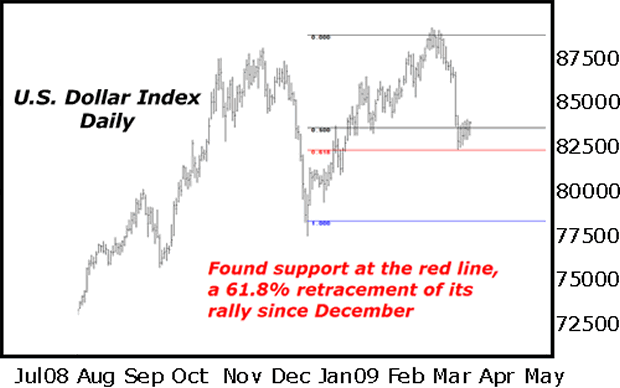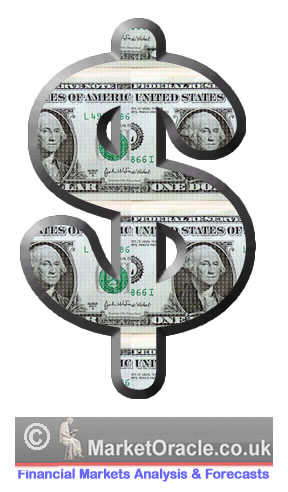U.S. Dollar Supported by Risk Averse Global Capital Flows
Currencies / US Dollar Mar 31, 2009 - 10:52 AM GMT Jack Crooks writes: Last week's big news: The Federal Reserve announced they'd “officially” take up quantitative easing to finance the massive stimulus spending.
Jack Crooks writes: Last week's big news: The Federal Reserve announced they'd “officially” take up quantitative easing to finance the massive stimulus spending.
The Fed's decision to buy long-term Treasuries, soak-up more mortgage debt and open up the Term Asset-Backed Securities Loan Facility (TALF) for the sake of consumers and small business inspired optimism …
Risk-takers came out of the woodwork with their wallets wide open. The result: Ongoing strength in the stock market.
Currency traders took the same cue as stock traders, and the U.S. dollar got clobbered. Many comments pointed at blatant debasement of the dollar … and a fiat currency race to the bottom.
There's nothing to say that this kneejerk reaction is off-base. There potentially could be a new, major rush out of U.S. dollars to fund global investment, just like we saw over most of the previous eight years.
But this Week It's a Whole Different Story …
Even though stocks continue to fight higher, the extreme dollar negativity has subsided. Investors are trying to keep their wits about them when others aren't exactly doing the same …
 |
| People's Bank of China Governor Zhou yucked it up with the media this week. But his remarks didn't cause much stir among the currencies. |
People's Bank of China Governor Zhou got buddy-buddy with the media this week. On Thursday, his words aimed at pumping unfounded optimism into the Chinese economy. And before that, he tried getting across his view that the International Monetary Fund's Special Drawing Right (SDR), a currency basket comprising dollars, euros, sterling and yen, should become a super-sovereign reserve currency.
Mr. Zhou's remarks didn't cause much stir among the currency markets. But sandwiched in between his comments was a remark by U.S. Treasury Secretary Geithner …
Geithner basically said he'd be willing to look at Mr. Zhou's proposal on SDRs. And while Mr. Geithner said he didn't expect the U.S. dollar to be supplanted as the world reserve currency, his comments were enough to get currency traders thinking it was possible.
All of this has given us little direction. But what's notable is that the U.S. dollar's correction has come to a breaking point. Whether it's a permanent ending or merely a temporary rest remains to be seen.
So far the broader fundamentals and sentiment driving the U.S. dollar and other currencies over the intermediate- and long-term haven't seemed to change. And at this point, the economic and political developments being dished out are not worrying me.
So the Dollar Could Be Ready to Move Higher Again …
Two pieces of recent economic data have me expecting more of the same risk-averse capital to be driving the U.S. dollar back higher soon:
- Japan's exports plunged nearly 50 percent in February — an obvious sign global demand has come to a screeching halt. Tack on the slowdown in exports for the U.S., China, and Germany and you've painted a real ugly picture for the export side of the global economy.
- U.S. fourth-quarter GDP sunk by 6.3 percent. This was more than had been expected. Perhaps it's a lagging indicator. But such a dramatic slowdown bodes ill for any bounce-back strength out of the U.S. consumer.
 |
| Japan, the U.S., China and Germany have seen exports plunge. An obvious sign global demand has come to a screeching halt. |
As bad as this sounds for the U.S., my expectations for the buck to outperform are based on the fact that the global economy is still so heavily dependent on the U.S. What's more, the U.S. has led the way down throughout this economic crisis, and now almost everyone else is playing catch-up.
Another potential supporting argument for the U.S. dollar rests on the near-term technical picture. The buck has shown resilience after a deep correction culminating with last week's onslaught. More specifically, it resisted ongoing selling pressure at a key retracement level.
Check out the chart below:

Source: CQG, Inc.
So what could be the driver for the next leg up in the dollar? My answer: The Group of 20 industrialized nations (G-20) meeting on April 2. The world's top “leaders” will meet to discuss possible solutions to the world's economic crisis. Many have called this upcoming meeting a make or break for global markets. I think it'll be a big, fat bust!
Why?
The Two Key Players Have Very Different Agendas …
The U.S. wants Europe to commit to additional government spending i.e. stimulus. And Europe wants the U.S. to commit to giving the International Monetary Fund (IMF) more money so the Eurozone banking system can be saved. But neither increasing government stimulus nor saving Eurozone banks will solve the broader problem of plummeting global demand.
 |
| Despite the train wreck within the U.S. economy, money will flow back to the deepest financial market in the world. |
And this lack of demand is what's responsible for the dramatic plunge in global trade, which is falling to levels not seen since the Great Depression.
The upshot of this will be another major bout of what is termed “risk aversion” — a sell-off of risky asset classes with a movement to safe havens. And despite the train wreck within the U.S. economy, the U.S. dollar wins by default.
As I've said in previous Money and Markets columns: The currency game is perverse and relative. Ultimately, currency prices are determined by global capital flow. And in a world with no place to hide, money flows back to the deepest financial market in the world … the U.S.
Best wishes,
Jack
This investment news is brought to you by Money and Markets . Money and Markets is a free daily investment newsletter from Martin D. Weiss and Weiss Research analysts offering the latest investing news and financial insights for the stock market, including tips and advice on investing in gold, energy and oil. Dr. Weiss is a leader in the fields of investing, interest rates, financial safety and economic forecasting. To view archives or subscribe, visit http://www.moneyandmarkets.com .
Money and Markets Archive |
© 2005-2022 http://www.MarketOracle.co.uk - The Market Oracle is a FREE Daily Financial Markets Analysis & Forecasting online publication.



